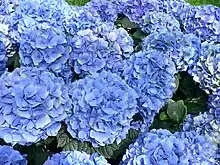
A metalloanthocyanin is a chemical complex giving color to petals of certain plants.
These complexes are self-assembled, supramolecular metal complex pigment composed of stoichiometric amounts of anthocyanins, flavones, and metal ions. The various colors, such as red, mauve, purple, violet and blue, in Hydrangea macrophylla are developed from one simple anthocyanin, delphinidin 3-glucoside forming complexes with metal ions.[1]
Examples
Commelinin, a blue pigment from the flowers of Commelina communis, is a complex of 4 Mg2+ ions chelating six anthocyanin molecules.[2]
Cyanosalvianin, a blue pigment from the flowers of Salvia uliginosa, is a complex formed of six molecules of the anthocyanin type, six molecules of the flavone type and two magnesium ions.[3]
References
- ↑ Yoshida K, Mori M, Kondo T (2009). "Blue flower color development by anthocyanins: from chemical structure to cell physiology". Nat. Prod. Rep. 26 (7): 884–915. doi:10.1039/b800165k. PMID 19554240.
- ↑ Shiono M, Matsugaki N, Takeda K (2008). "Structure of commelinin, a blue complex pigment from the blue flowers of Commelina communis". Proc. Jpn. Acad., Ser. B, Phys. Biol. Sci. 84 (10): 452–6. doi:10.2183/pjab.84.452. PMC 3720548. PMID 19075517.
- ↑ Mori M, Kondo T, Yoshida K (December 2008). "Cyanosalvianin, a supramolecular blue metalloanthocyanin, from petals of Salvia uliginosa". Phytochemistry. 69 (18): 3151–8. doi:10.1016/j.phytochem.2008.03.015. PMID 18466933.
External links